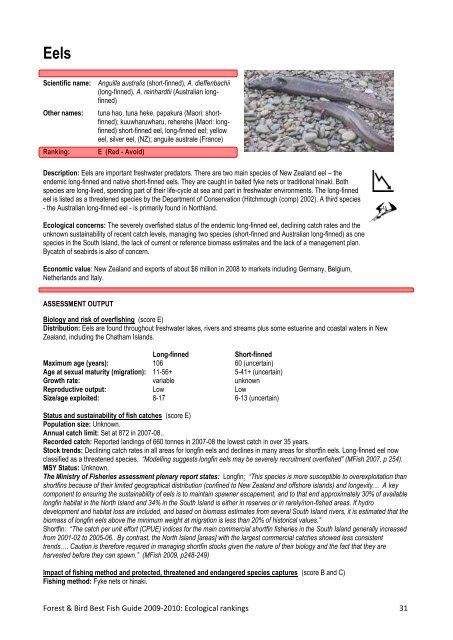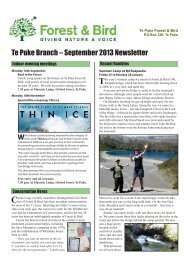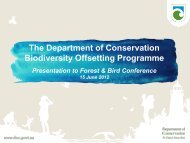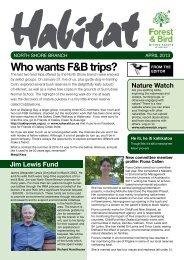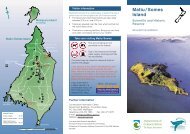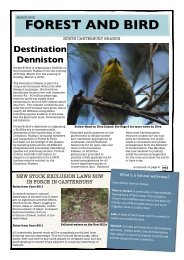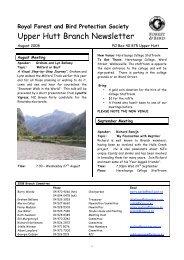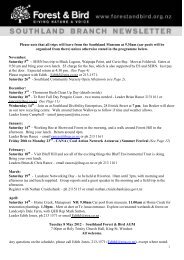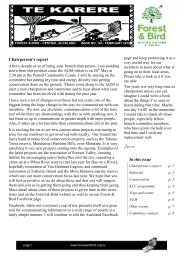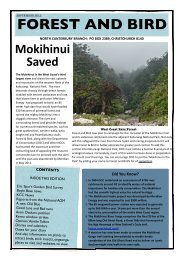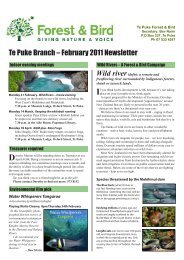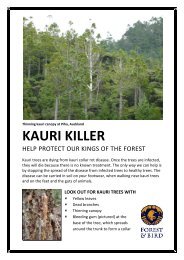Best Fish Guide 2009-2010 - Forest and Bird
Best Fish Guide 2009-2010 - Forest and Bird
Best Fish Guide 2009-2010 - Forest and Bird
Create successful ePaper yourself
Turn your PDF publications into a flip-book with our unique Google optimized e-Paper software.
Eels<br />
Scientific name: Anguilla australis (short-finned), A. dieffenbachii<br />
(long-finned), A. reinhardtii (Australian longfinned)<br />
Other names: tuna hao, tuna heke, papakura (Maori: shortfinned);<br />
kuuwharuwharu, reherehe (Maori: longfinned)<br />
short-finned eel, long-finned eel; yellow<br />
eel, silver eel, (NZ); anguile australe (France)<br />
Ranking: E (Red - Avoid)<br />
Description: Eels are important freshwater predators. There are two main species of New Zeal<strong>and</strong> eel – the<br />
endemic long-finned <strong>and</strong> native short-finned eels. They are caught in baited fyke nets or traditional hinaki. Both<br />
species are long-lived, spending part of their life-cycle at sea <strong>and</strong> part in freshwater environments. The long-finned<br />
eel is listed as a threatened species by the Department of Conservation (Hitchmough (comp) 2002). A third species<br />
- the Australian long-finned eel - is primarily found in Northl<strong>and</strong>.<br />
Ecological concerns: The severely overfished status of the endemic long-finned eel, declining catch rates <strong>and</strong> the<br />
unknown sustainability of recent catch levels, managing two species (short-finned <strong>and</strong> Australian long-finned) as one<br />
species in the South Isl<strong>and</strong>, the lack of current or reference biomass estimates <strong>and</strong> the lack of a management plan.<br />
Bycatch of seabirds is also of concern.<br />
Economic value: New Zeal<strong>and</strong> <strong>and</strong> exports of about $6 million in 2008 to markets including Germany, Belgium,<br />
Netherl<strong>and</strong>s <strong>and</strong> Italy.<br />
ASSESSMENT OUTPUT<br />
Biology <strong>and</strong> risk of overfishing (score E)<br />
Distribution: Eels are found throughout freshwater lakes, rivers <strong>and</strong> streams plus some estuarine <strong>and</strong> coastal waters in New<br />
Zeal<strong>and</strong>, including the Chatham Isl<strong>and</strong>s.<br />
Long-finned Short-finned<br />
Maximum age (years): 106 60 (uncertain)<br />
Age at sexual maturity (migration): 11-56+ 5-41+ (uncertain)<br />
Growth rate: variable unknown<br />
Reproductive output: Low Low<br />
Size/age exploited: 8-17 6-13 (uncertain)<br />
Status <strong>and</strong> sustainability of fish catches (score E)<br />
Population size: Unknown.<br />
Annual catch limit: Set at 872 in 2007-08..<br />
Recorded catch: Reported l<strong>and</strong>ings of 660 tonnes in 2007-08 the lowest catch in over 35 years.<br />
Stock trends: Declining catch rates in all areas for longfin eels <strong>and</strong> declines in many areas for shortfin eels. Long-finned eel now<br />
classified as a threatened species. “Modelling suggests longfin eels may be severely recruitment overfished” (M<strong>Fish</strong> 2007, p 254).<br />
MSY Status: Unknown.<br />
The Ministry of <strong>Fish</strong>eries assessment plenary report states: Longfin: “This species is more susceptible to overexploitation than<br />
shortfins because of their limited geographical distribution (confined to New Zeal<strong>and</strong> <strong>and</strong> offshore isl<strong>and</strong>s) <strong>and</strong> longevity… A key<br />
component to ensuring the sustainability of eels is to maintain spawner escapement, <strong>and</strong> to that end approximately 30% of available<br />
longfin habitat in the North Isl<strong>and</strong> <strong>and</strong> 34% in the South Isl<strong>and</strong> is either in reserves or in rarely/non-fished areas. If hydro<br />
development <strong>and</strong> habitat loss are included, <strong>and</strong> based on biomass estimates from several South Isl<strong>and</strong> rivers, it is estimated that the<br />
biomass of longfin eels above the minimum weight at migration is less than 20% of historical values.”<br />
Shortfin: “The catch per unit effort (CPUE) indices for the main commercial shortfin fisheries in the South Isl<strong>and</strong> generally increased<br />
from 2001-02 to 2005-06.. By contrast, the North Isl<strong>and</strong> [areas] with the largest commercial catches showed less consistent<br />
trends…. Caution is therefore required in managing shortfin stocks given the nature of their biology <strong>and</strong> the fact that they are<br />
harvested before they can spawn.” (M<strong>Fish</strong> <strong>2009</strong>, p248-249)<br />
Impact of fishing method <strong>and</strong> protected, threatened <strong>and</strong> endangered species captures (score B <strong>and</strong> C)<br />
<strong>Fish</strong>ing method: Fyke nets or hinaki.<br />
<strong>Forest</strong> & <strong>Bird</strong> <strong>Best</strong> <strong>Fish</strong> <strong>Guide</strong> <strong>2009</strong>-<strong>2010</strong>: Ecological rankings 31


